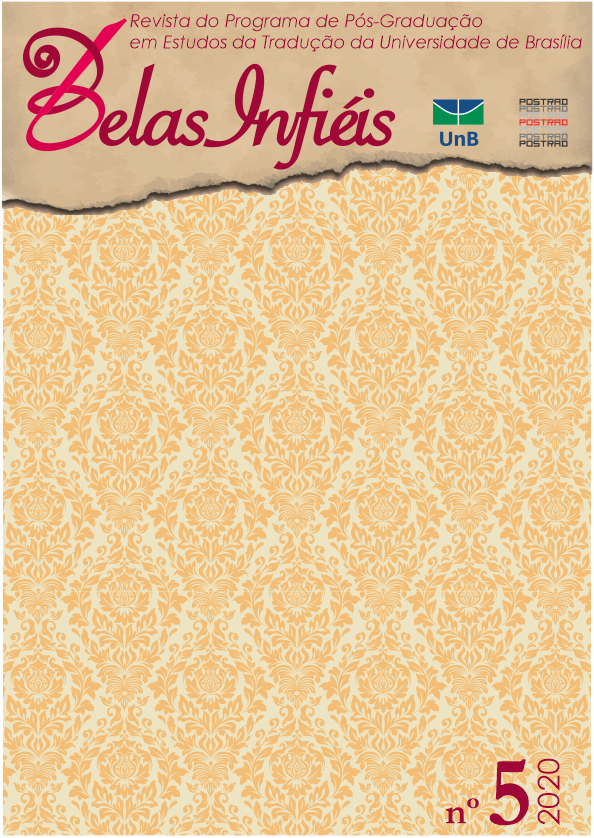Resenha de Translating Picturebooks: Revoicing the Verbal, the Visual, and the Aural for a Child Audience
DOI:
https://doi.org/10.26512/belasinfieis.v9.n5.2020.31975Palavras-chave:
Tradução. Livros ilustrados. Literatura infantil. Multimodalidade.Resumo
Esta resenha comenta a obra Translating Picturebooks: Revoicing the Verbal, the Visual, and the Aural for a Child Audience [Traduzindo livros ilustrados: revocalizando o verbal, o visual e o oral para um público infantil], de autoria de Riitta Oittinen, Anne Ketola e Melissa Garavini. A obra trata da tradução de livros ilustrados para crianças, com foco nas peculiaridades das obras ilustradas enquanto entidades multimodais. Abordam-se as implicações da ilustração na prática tradutória e a recepção das traduções por um público que inclui adultos e crianças. A reflexão se insere no âmbito dos estudos da tradução ligados à multimodalidade e à literatura infantil.
Downloads
Referências
BELL, Allan. Language Style as Audience Design. Language in Society 13, p. 145-204, 1984.
BELL, Allan. Back in Style: Reworking Audience Design. In: ECKERT, P. e RICKFORD, J. (org.). Style and Sociolinguistic Variation. New York: Cambridge University Press, 2001, p. 139-169.
BERGER, Arthur Asa. Seeing Is Believing: An Introduction to Visual Communication. London and Toronto: Mayfield Publishing Company, 1998.
BOSCH ANDREU, Emma. Hacia una definición de álbum. Anuario de investigación en literatura infantil y juvenil 5, p. 25-46, 2007.
FRANCO AIXELÁ, Javier. Culture-specific Items in Translation. In: ÁLVAREZ, R. e ÁFRICA VIDAL, M. C. (org.). Translation, Power, Subversion. Clevedon: Multilingual Matters, 1996. p. 52-78.
GILE, Daniel. Integrated Problem and Decision Reporting as a Translator Training Tool. Journal of Specialised Translation 2, p. 2-20, 2004. Disponível em: www.jostrans.org/issue02/art_gile.pdf Acesso em: 09 jun. 2020.
GOLDEN, Seán. Whose Morsel of Lips Will You Bite? Some Reflections on the Role of Prosody and Genre as Non-verbal Elements in the Translation of Poetry. In: POYATOS, F. (org.). Nonverbal Communication and Translation: New Perspectives and Challenges in Literature, Interpretation and the Media. Amsterdam and Philadelphia: John Benjamins Publishing Company, 1997. p. 217-247.
JAKOBSON, Roman. On Linguistic Aspects of Translation. In: BROWER, R. A. (org.). On Translation. New York: Oxford University Press, 1966. p. 232-239.
KRESS, Günther; VAN LEEUWEN, Theo. Reading Images: The Grammar of Visual Design. London and New York: Routledge, 1996.
LEFEVERE, André. Mother Courage’s Cucumbers: Text, System and Refraction in a Theory of Literature. In: VENUTI, L. (org.). The Translation Studies Reader, 3rd ed. London: Routledge, 2012. p. 203-219.
LEWIS, David. Reading Contemporary Picturebooks: Picturing Text. London: Routledge, 2001.
OITTINEN, Riitta. Translating for Children. New York: Garland Publishing, 2000.
O’SULLIVAN, Emer. Comparative Children’s Literature. Translated by Anthea Bell. London and NY: Routledge, 2005. Based on: Kinderliterarische Komparatistik.
PEIRCE, Charles S. Collected Papers by Charles Sanders Peirce. Cambridge: Harvard University Press, 1932.
ROSENBLATT, Louise M. The Reader, the Text, the Poem: The Transactional Theory of the Literary Work. Carbondale and Edwardsville: Southern Illinois University Press, 1978.
SHAVIT, Zohar. Poetics of Children’s Literature. Athens and London: University of Georgia Press, 1986.
TOURY, Gideon. In Search of a Theory of Translation. Tel Aviv: The Porter Institute for Poetics and Semiotics, 1980.
VENUTI, Lawrence. The Translator’s Invisibility: A History of Translation. London: Routledge, 1995.
Downloads
Publicado
Como Citar
Edição
Seção
Licença
Copyright (c) 2020 CC BY

Este trabalho está licenciado sob uma licença Creative Commons Attribution 4.0 International License.
Dado ao acesso público desta revista, os textos são de uso gratuito, com obrigatoriedade de reconhecimento da autoria original e da publicação inicial nesta revista
A revista permitirá o uso dos trabalhos publicados para fins não comerciais, incluindo direito de enviar o trabalho para bases de dados de acesso público. As contribuições publicadas são de total e exclusiva responsabilidade dos autores.
Os autores, ao submeterem trabalhos para serem avaliados pela revista Belas Infiéis, mantêm os direitos autorais e concedem à revista o direito de primeira publicação, sendo o trabalho licenciado sob a Creative Commons Attribution License Atribuição 4.0 Internacional (CC BY 4.0).



















